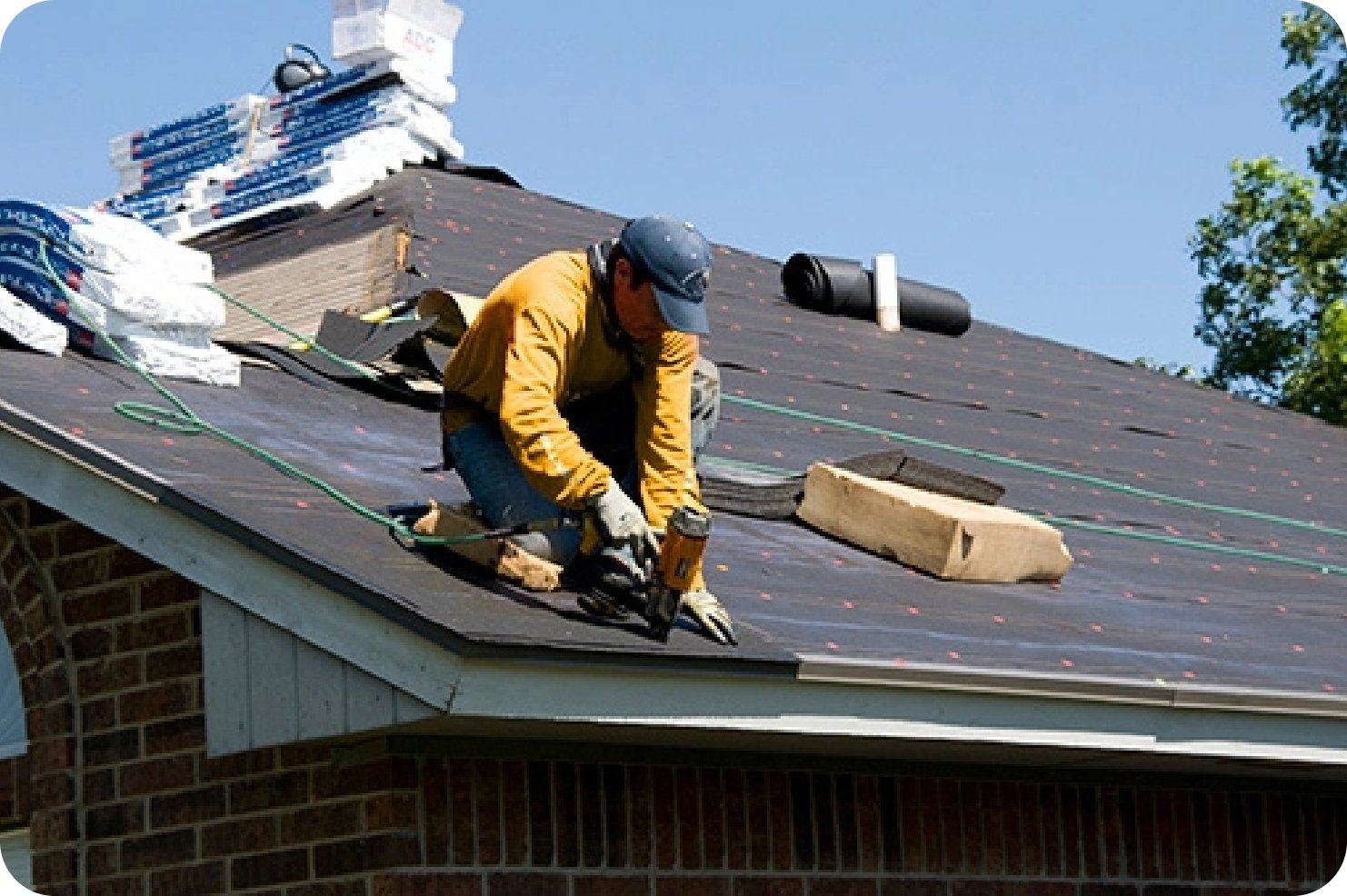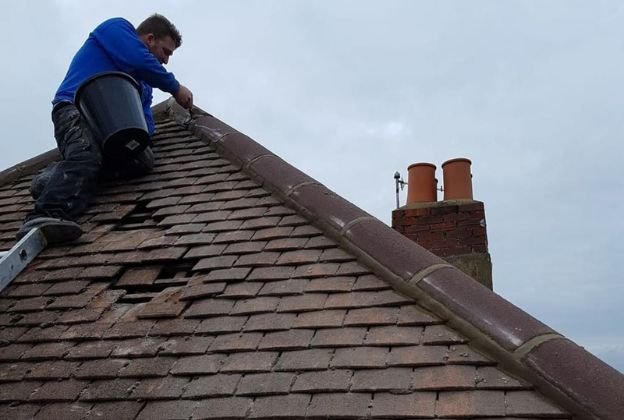Discovering the Various Sorts Of Roofing Systems: Which One Is Best for Your Home?
When thinking about the myriad kinds of roofings offered, it is vital to examine exactly how each option straightens with your home's unique demands, including environment conditions, visual choices, and architectural functionality. From the classic gable roof that efficiently networks rainwater to the modern flat roof covering offering city flexibility, each design offers unique benefits and challenges.
Gable Roofings
Saddleback roofs, identified by their triangular shape and sloping sides, are a preferred selection among property owners looking for both visual charm and capability. This roof covering style effectively permits reliable water runoff, lowering the threat of water merging and subsequent damages. In addition, the steep inclines produce ample attic room, which can be utilized for storage and even converted into living areas.
One of the primary advantages of gable roofing systems is their capability to endure harsh climate condition. The style helps in reducing wind resistance, making them specifically appropriate for areas prone to storms. Furthermore, saddleback roofs can be constructed utilizing a range of materials, consisting of shingles, floor tiles, and steel, giving house owners with flexibility in layout and budget plan.
From an architectural perspective, gable roofings can enhance the visual appeal of a home, supplying a traditional and timeless look. Overall, gable roofs continue to be a popular alternative due to their balance of functionality and style, appealing to a vast variety of homeowners.
Apartment Roofs
While often overlooked for even more conventional roofing styles, level roof coverings offer special advantages that accommodate details architectural needs and modern-day layout choices. These roof coverings are characterized by their marginal pitch, enabling efficient use area, especially in urban settings where taking full advantage of square video is vital.
One substantial advantage of flat roof coverings is their convenience. They can be utilized as additional living rooms, such as rooftop yards, outdoor patios, or photovoltaic panel installments, improving the capability of a home. Furthermore, level roof coverings are typically simpler and much safer to browse during upkeep, assisting in repairs and assessments without the challenges presented by steep slopes.
Flat roofs can also be more cost-effective in terms of products and installment. With a less complex style, they often require less sources, equating right into lower labor expenses. Nonetheless, it's important to consider drain and waterproofing, as level roofing systems can be vulnerable to merging water if not adequately developed.

Hip Roof Coverings
Hip roof coverings stand out for their elegant layout and architectural integrity, making them a preferred option amongst house owners. Defined by slopes on all 4 sides, hip roof coverings supply a healthy aesthetic that enhances various building designs - roof repair oahu. The in proportion nature of these roofs assists to distribute weight uniformly, improving security and durability
One of the vital advantages of hip roofs is their ability to hold up against extreme climate condition. The sloped surfaces facilitate reliable water drain and snow drainage, decreasing the danger of leaks and structural damage. In addition, the design minimizes wind resistance, making hip roofings less vulnerable to wind uplift contrasted to other roof covering kinds.


Dropped Roofings
Shed roof coverings, as opposed to the intricacy of hip roofings, supply a minimal and streamlined style that charms to contemporary looks. Characterized by a single sloping surface area, lost roof coverings are usually used in modern architecture, yard sheds, and other functional frameworks. This simplicity not just boosts aesthetic charm yet likewise enables efficient water drainage, making them ideal for numerous environments.
Among the primary benefits of shed roofing systems is their description cost-effectiveness. With fewer products called for and a simple installment process, homeowners can conserve both money and time. The layout also permits the incorporation of large home windows or skylights, promoting all-natural light and developing roomy interiors.
Nonetheless, it is essential to consider the prospective disadvantages, consisting of limited insulation options and the demand for careful design to stay clear of too much warmth accumulation. In addition, dropped roofing systems might not blend effortlessly with conventional style, which can be a concern for some home owners.
Inevitably, dropped roofing systems present a functional and elegant roofing service for those seeking modernity and efficiency. When selecting a roof kind, evaluating individual useful needs and visual choices will assist house owners to the most effective selection for their unique demands.
Mansard Roofing Systems
Mansard roofs, defined by their distinct four-sided layout, are a hallmark of French design that combines sophistication with performance. This building style includes 2 slopes on each side, with the reduced slope being steeper than the upper one. The distinct setup permits extra living room in the top levels, making it an excellent option for house owners looking for to make best use of functional location without expanding the building's footprint.
Among the significant benefits of a mansard roofing is its adaptability. It can be adjusted to various architectural styles, from conventional to contemporary, boosting the aesthetic allure of any type of home. Furthermore, the enough space produced under the roofing system can quickly fit dormer home windows, which enable natural light and ventilation, more enhancing the comfort of the living location.
Nonetheless, possible homeowners need to take into consideration the maintenance needs associated with mansard roof coverings. Installation expenses might be higher contrasted to simpler roof styles due to the intricacy of building and construction.
Verdict
To conclude, the choice of a suitable roofing system kind depends upon private demands, climate factors to consider, and aesthetic choices. Each roofing style provides special advantages, such as the effectiveness of gable roof coverings, the modern-day charm of shed roof coverings, and the security of hip roof coverings. Furthermore, level roofings use practicality for city settings, while mansard roofing systems provide added home regardless of higher installment expenses. Ultimately, a complete analysis of these aspects will certainly direct homeowners in making a notified decision.
From the traditional gable roof covering that efficiently channels rain to the contemporary level roofing system offering metropolitan flexibility, each style provides distinctive advantages and challenges (roof repair oahu). Furthermore, the layout minimizes wind resistance, making hip roofing systems much less at risk to wind uplift compared to other roofing kinds
Shed roofing systems, in contrast to the complexity of hip roofings, supply a minimal and structured layout that appeals to modern looks. Each roof covering style presents unique advantages, such Learn More Here as the effectiveness of gable roofings, the contemporary charm of shed roofings, and the security of hip roofs. Flat roofs provide practicality for helpful hints urban environments, while mansard roofing systems give additional living space despite higher installment prices.